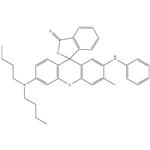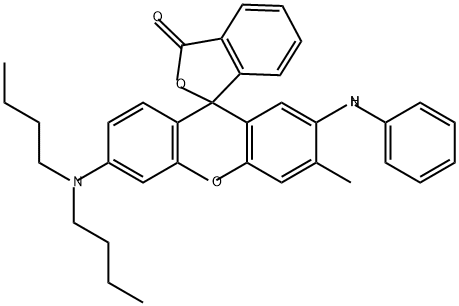2-Anilino-6-dibutylamino-3-methylfluoran: properties, applications and safety
Nov 10,2023
General Description
2-Anilino-6-dibutylamino-3-methylfluoran is a valuable component for light-driven phase change material systems with temperature-control capabilities. Its notable properties include high light absorption, thermochromism, thermal stability, and reversibility. Incorporating this compound into thermochromic phase change materials enables the conversion of visible light into thermal energy and the precise regulation of temperature during the phase change process. This application potential lies in various fields, including thermal energy storage systems, smart windows, and temperature-sensitive devices. However, safety must be prioritized when handling 2-Anilino-6-dibutylamino-3-methylfluoran, due to its hazardous nature and potential health risks. Proper handling, storage, and necessary precautions are essential to minimizing these risks.

Figure 1. 2-Anilino-6-dibutylamino-3-methylfluoran
Properties
2-Anilino-6-dibutylamino-3-methylfluoran is a compound with unique properties. Firstly, 2-Anilino-6-dibutylamino-3-methylfluoran exhibits excellent light absorption capabilities in the visible region of the electromagnetic spectrum. This property allows it to efficiently convert visible light into thermal energy, which can be stored as latent heat. The high absorbance of 2-Anilino-6-dibutylamino-3-methylfluoran makes it an ideal candidate for light-driven systems. Secondly, 2-Anilino-6-dibutylamino-3-methylfluoran demonstrates thermochromic behavior, meaning its color changes with temperature variations. This property enables the monitoring and control of temperature during phase change processes. By incorporating 2-Anilino-6-dibutylamino-3-methylfluoran into phase change materials, the equilibrium temperature can be regulated, preventing it from reaching excessively high levels. Additionally, 2-Anilino-6-dibutylamino-3-methylfluoran possesses good thermal stability, ensuring its performance over multiple heating and cooling cycles without significant degradation or loss of functionality. This stability enhances the durability and longevity of systems incorporating 2-Anilino-6-dibutylamino-3-methylfluoran. In summary, 2-Anilino-6-dibutylamino-3-methylfluoran displays notable properties, including high light absorption, thermochromism, thermal stability, and reversibility. These properties make it a valuable component for light-driven phase change material systems with temperature-control capabilities. 1
Applications
2-Anilino-6-dibutylamino-3-methylfluoran has been successfully incorporated into thermochromic phase change materials (TC-PCMs) to create a light-driven phase change material system with temperature-control properties. By introducing 2-Anilino-6-dibutylamino-3-methylfluoran and bisphenol A (BPA) into 1-hexadecanol (1-HD), the TC-PCMs demonstrated the ability to convert visible light into thermal energy and store it as latent heat. The key advantages of the TC-PCMs are their ability to achieve lower equilibrium temperatures compared to conventional PCMs and their excellent reversibility and repeatability over multiple cycles of light exposure and cooling. The low equilibrium temperature is achieved through variations in absorbance induced by 2-Anilino-6-dibutylamino-3-methylfluoran, allowing for more precise temperature control during the phase change process. The application potential of TC-PCMs lies in various fields, including thermal energy storage systems, smart windows, and temperature-sensitive devices. In thermal energy storage systems, TC-PCMs can efficiently capture and store solar or waste heat for later use. They can also be integrated into smart windows to regulate indoor temperature by adjusting the light transmission and heat absorption properties. Overall, the incorporation of 2-Anilino-6-dibutylamino-3-methylfluoran into TC-PCMs opens up new possibilities for light-driven phase change material systems with improved temperature-control properties, enabling more efficient energy utilization and enhanced performance in various applications. 2
Safety
2-Anilino-6-dibutylamino-3-methylfluoran is a chemical compound widely used in various industries. However, it is crucial to prioritize safety when handling this substance. Firstly, 2-Anilino-6-dibutylamino-3-methylfluoran has been classified as a hazardous material due to its potential health risks. It is important to minimize exposure by wearing appropriate personal protective equipment such as gloves, safety goggles, and a lab coat. Inhalation should be avoided, and if necessary, a respirator must be worn. Moreover, 2-Anilino-6-dibutylamino-3-methylfluoran should be handled in a well-ventilated area to prevent the accumulation of vapors. It is flammable, so all potential ignition sources should be eliminated. Additionally, it is essential to store DABFM in tightly sealed containers away from heat and incompatible substances. In case of accidental contact with 2-Anilino-6-dibutylamino-3-methylfluoran, immediate action must be taken. Any spills should be contained and cleaned up using appropriate absorbent materials. If there is direct skin or eye contact, rinsing with plenty of water for at least 15 minutes is vital, while seeking medical attention is strongly recommended. Overall, ensuring the safety of individuals working with 2-Anilino-6-dibutylamino-3-methylfluoran involves proper handling, storage, and the use of necessary precautions to minimize potential risks. 3
Reference
1. PubChem. COMPOUND SUMMARY: 2-Anilino-3-methyl-6-(dibutylamino)fluoran. National Library of Medicine, 2005, PubChem CID: 3534526.
2. Ren C, Liu F, Umair MM, Jin X, Zhang S, Tang B. Excellent Temperature-Control Based on Reversible Thermochromic Materials for Light-Driven Phase Change Materials System. Molecules. 2019 Apr 24;24(8):1623.
3. Hazardous Chemical Information System. Hazardous Chemical Details: 6'-(dibutylamino)-3'-methyl-2'-(phenylamino)spiro[isobenzofuran-1(3H),9-(9H)-xanthen]-3-one. Safe work Australia, 2016.
- Related articles
- Related Qustion
- 2-Anilino-6-dibutylamino-3-methylfluoran: Overview, Applications in Light-Driven Phase Change Materials System and Preparation Method Mar 29, 2024
2-Anilino-6-dibutylamino-3-methylfluoran's UV-triggered color change aids security measures and is vital for precise phase change materials, ensuring stable temperatures with efficient synthesis.
- Application of 2-Anilino-6-dibutylamino- 3-methylfluoran Nov 6, 2019
2-Anilino-6-dibutylamino- 3-methylfluoran is an important organic fluorescent dye, used widely in the chemical field.
2-Anilino-6-dibutylamino-3-methylfluoran
89331-94-2You may like
2-Anilino-6-dibutylamino-3-methylfluoran manufacturers
- 2-Anilino-6-dibutylamino-3-methylfluoran
-

- $0.00 / 25Kg/Drum
- 2024-06-05
- CAS:89331-94-2
- Min. Order: 1KG
- Purity: 99%
- Supply Ability: 500mt/year
- 2-Anilino-6-dibutylamino-3-methylfluoran ODB2
-

- $99.00 / 1kg
- 2024-05-16
- CAS:89331-94-2
- Min. Order: 1kg
- Purity: 99%
- Supply Ability: 20ton
- 2-Anilino-6-dibutylamino-3-methylfluoran
-

- $8.00 / 1KG
- 2024-04-09
- CAS:89331-94-2
- Min. Order: 1KG
- Purity: 99%
- Supply Ability: g-kg-tons, free sample is available




